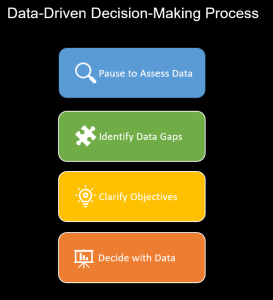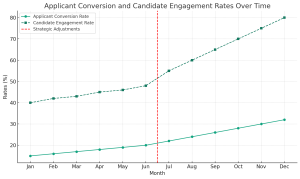“The best way to predict the future is to create it.” – Peter Drucker
Introduction
In the dynamic world of talent acquisition, where intuition once led the way, the advent of data analytics heralds a new dawn of precision and insight. Embarking on a journey from understanding to applying data in talent sourcing, this series aims not merely to collect data but to foster a mindset attuned to its profound implications. It seeks to empower talent sourcing professionals to question, understand, and apply data to make informed decisions.
Highlighted by David Green in his June 2023 insights, research from Visier illuminates the substantial value of data in the talent space. For a 10,000-person organization, effectively democratizing people data can unlock nearly $400 million in cost savings and close to $200 million in revenue expansion. This compelling evidence serves as a rallying cry for talent sourcers and HR professionals to embrace the power of data in their practices.
This article endeavors to equip talent sourcing professionals with the necessary tools and habits to adeptly navigate the vast information landscape. It emphasizes the importance of pausing to assess available data before making decisions, identifying and addressing data collection gaps, and ensuring actions align with well-defined objectives. Through exploring practical ways to transform insights into actions, this piece champions a culture where data informs strategy, fostering improved outcomes for both individuals and organizations.
Section 1: Cultivating a Data-First Mindset

1.1 Pausing to Assess the Data
In our fast-paced world, taking a moment to pause before acting is invaluable, especially when building a data-driven mindset. Before diving into decisions or launching new initiatives, it’s critical to assess the data you have at your disposal. This contemplative pause goes beyond mere number-crunching; it involves a deep dive into the available information, understanding its implications, and identifying any missing pieces. Such deliberate reflection ensures that decisions are not merely reactive but are strategically informed by data. For instance, before embarking on a quest to fill a new position, take a moment to review historical data on similar roles—examining past success stories and learning from them can significantly enhance the efficiency and effectiveness of your talent identification process.
1.2 Identifying Missing Data
The act of pausing often reveals gaps in our knowledge. You may find yourself wishing for insights into the skills of top applicants for similar roles in the past, only to realize such data isn’t readily accessible. At this juncture, it’s crucial to determine whether the data is out of reach or simply uncollected. This is where forging strong connections across the organization, particularly with Talent Acquisition (TA) and Human Resources (HR) functions, becomes essential. A quick inquiry to a People Analytics colleague or a team leader might unveil that the needed information exists and can be shared, potentially even in a pre-analyzed format, providing direct insights to guide your next steps. In the worst-case scenario, identifying a data collection gap can lead to new initiatives to gather this crucial information moving forward, ensuring better-informed decisions in the future.
1.3 Clarifying Objectives and Questions
At the heart of data-driven decision-making lies clarity of purpose. Before you delve into data analysis or decision-making, it’s paramount to have a clear understanding of your goals and the specific questions you’re seeking to answer. Whether you’re looking to decrease time-to-source by exploring more efficient sourcing channels or aiming to enhance the quality of hires through improved screening processes, defining these objectives upfront ensures that your engagement with data is targeted and impactful. For example, aiming to diversify the talent pipeline for tech roles might prompt the question: “What has been the demographic breakdown of applicants for similar positions historically, and how does that compare to our current applicant pool?” This not only focuses efforts on a clear diversity objective but also directs data analysis towards strategic goal alignment. By transitioning from generic strategies to targeted actions, talent sourcers can lay the groundwork for a more inclusive and effective recruitment process.
In building out this framework, the goal is to shift from instinctual to intentional action, grounding every decision in data. This approach not only improves the quality and effectiveness of talent sourcing strategies but also fosters a culture of critical thinking and continuous improvement. Let’s dive into how these foundational practices can be applied to practical talent sourcing scenarios, enhancing both individual and organizational performance in the competitive talent marketplace.
Section 2: Practical Applications in Talent Sourcing
2.1 Time-Based Metrics
At the core of effectively leveraging data is its application to refine and enhance strategies. Metrics such as time to source and time to fill serve as quantifiable benchmarks of the talent sourcing and acquisition process’s efficiency. For instance, if analysis reveals that sourcing for software engineering roles has extended from 60 to 90 days, this discrepancy necessitates a thorough investigation. Possible factors include shifts in market dynamics, changes in job requirements, or inefficiencies in internal processes. Responding to these insights with strategic adjustments, like exploring untapped sourcing channels or enhancing employee referral programs, aims to optimize these metrics. Embracing this iterative process—constantly measuring, adjusting, and reassessing—enables talent sourcers to improve their effectiveness in alignment with organizational needs.

2.2 Evaluating Ratios
Ratios such as applicant conversion rates and candidate engagement rates play a pivotal role in evaluating the efficacy of sourcing strategies. For example, a low conversion rate from sourced candidates to applicants may signal a disconnect in engagement strategies, suggesting that passive candidates aren’t sufficiently motivated to apply. Conversely, a drop in the conversion rate from applicants to interviewees might indicate a misalignment between the sourcing team’s efforts and the business’s expectations, possibly due to overlooked candidate qualities or unconscious biases. Strategically addressing these discrepancies by adjusting engagement tactics or improving communication between teams can significantly impact talent outcomes. This data-driven approach to problem-solving enhances sourcing tactics’ relevance and effectiveness.
2.3 Adopting an Experimental Approach
Implementing an experimental approach in talent sourcing introduces continuous feedback loops that not only improve data quality but also refine sourcing outcomes. For example, initiatives aimed at diversifying the candidate pool may include experimenting with various strategies, such as targeted outreach or partnerships with diversity-focused organizations. By establishing clear success metrics and diligently monitoring the impact of these experiments, talent sourcers can swiftly identify effective strategies. This adaptable mindset not only encourages innovation but also ensures that sourcing tactics are continually aligned with evolving organizational goals. Rather than restarting with each new search, a data-driven talent sourcer fine-tunes their approach based on lessons learned from both successes and failures, fostering a cycle of continuous improvement and strategic alignment.
The practical application of data in talent sourcing transcends mere number crunching; it is about leveraging those insights to make informed decisions that significantly enhance recruitment strategies and employer branding. Embracing a data-driven approach not only refines our sourcing techniques but also solidifies our employer brand. Remarkably, statistics from Deloitte reveal that a strong employer brand, underpinned by data-driven insights, can reduce hiring costs by up to 50% and cut turnover rates by 28%. This demonstrates the profound impact of integrating data analytics into talent sourcing, highlighting how strategic use of data contributes not just to immediate recruitment success but to long-term organizational health and efficiency. Through strategic evaluation of time-based metrics and the iterative refinement of sourcing approaches, talent sourcers equipped with data-driven insights are better positioned to meet the evolving challenges of the talent marketplace, enhancing both individual and organizational performance.
Section 3: Broader Organizational Impacts of Data-Driven Talent Sourcing

3.1 Understanding Organizational Influence
The ramifications of a data-driven talent sourcing strategy ripple far beyond the HR and talent acquisition departments, influencing the entire organization. It’s important to remember that the allocation of resources for a Talent Acquisition function and a dedicated team of Sourcers is not merely for sourcing exceptional talent; it fundamentally aims to enhance the organization’s health. By weaving data insights into sourcing strategies, you can transcend the role of a talent acquisition expert to become a pivotal contributor to the operational efficiency and financial well-being of the company. For instance, streamlining the sourcing process to expedite the filling of critical roles can quicken project completions, boosting productivity, and, consequently, driving revenue growth and brand success. Likewise, elevating the quality of hires through informed sourcing and assessment practices can diminish turnover rates, yielding significant cost savings. Recognizing the strategic value of these effects underscores the profound organizational impact of data-driven approaches.
3.2 Balancing Data with Empathy
Data guides informed decision-making, yet it must be harmonized with empathy to fully grasp the human dimension of talent sourcing. When data signals a diversity shortfall within the candidate pool, it’s imperative to contemplate the wider societal and systemic influences at play. Strategies that address numeric goals while nurturing an inclusive, supportive environment for all candidates are essential. This balanced approach not only aims to enhance organizational metrics but also positively shapes the candidate experience and cultivates a richer company culture.
3.3 Leveraging Data for Strategic Alignment
A data-driven talent sourcing strategy emerges as a formidable asset in aligning talent acquisition with overarching business goals. Suppose an organization sets its sights on breaking new ground in markets or unveiling innovative products. In that case, talent sourcing can harness data to pinpoint and attract individuals endowed with the requisite skills and experiences. Consider a scenario where a sourcer, armed with precise data, understands the need not merely for a developer experienced in node.js with a media background but for someone specifically passionate about crafting a groundbreaking streaming platform to redefine film distribution. Tailoring the search to align with the company’s strategic ambitions to disrupt the media and entertainment sector ensures the recruitment of talent that not only meets technical demands but is also deeply committed to the organizational vision.
The impact of data-driven talent sourcing significantly influences organizational operational efficiency, financial robustness, and strategic direction. Talent sourcing professionals, by understanding these broad implications, elevate their roles, contributing to their teams’ and the company’s overarching goals. For instance, strategic workforce planning (SWP), achievable through data sharing between HR and the business, notably enhances the success rate of digital transformations, as highlighted by McLean & Co.’s 2024 HR Trends Report. This section has demonstrated the extensive benefits of incorporating data into talent sourcing, illustrating that its value surpasses individual hires to affect the organization’s entire trajectory. Finally, let’s synthesize these concepts, demonstrating how a thoughtful, question-driven engagement with data sets the stage for delivering superior outcomes.
Conclusion
Throughout “Demystifying Data for Talent Sourcers Part Two: Practical Tips for Building a Data-Driven Mindset,” we’ve embarked on an in-depth exploration into the transformative potential of embedding data into every facet of talent sourcing. We began by emphasizing the importance of cultivating a mindset that prioritizes data assessment before action, identifying data gaps, and aligning every initiative with clear, strategic objectives. Our journey has illustrated how practical applications of time-based metrics and ratios can significantly refine sourcing strategies. Moreover, we highlighted the value of adopting an experimental mindset, enabling talent sourcers to adapt and evolve their approaches in response to real-time feedback and organizational goals.
Consider the scenario of leveraging this data-driven mindset to fill a crucial role within an innovative tech division focused on sustainable energy solutions. By analyzing historical data, identifying engagement gaps among female candidates, and subsequently pioneering new sourcing strategies, talent sourcing professionals can dramatically enhance the diversity and quality of the candidate pool. This not only expedites the hiring process but also aligns talent acquisition with the company’s mission to lead in sustainable technology, showcasing HR and talent acquisition as strategic pillars within the organization.
This series has underscored the fact that being a superhero sourcer in today’s digital age transcends merely finding the right candidates; it’s about harnessing the power of data to make informed decisions that propel the company’s strategic objectives forward. Yet, the exploration doesn’t conclude here. Future articles will delve into the realms of AI, advanced data analytics, and their implications for the future of talent sourcing. Stay tuned as we continue to navigate the evolving landscape of data and sourcing, equipping you to tackle the challenges and seize the opportunities of tomorrow’s talent marketplace with confidence and strategic insight.
